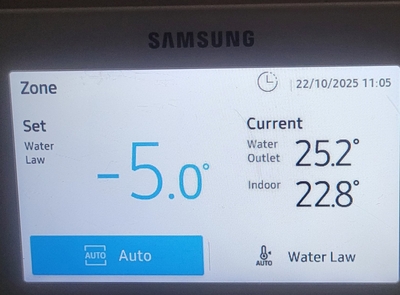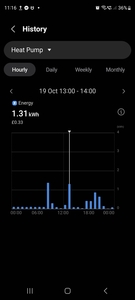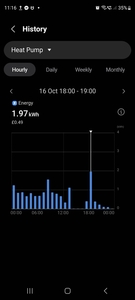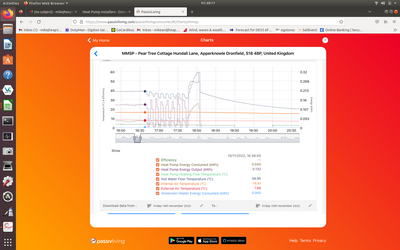Replacing knackered oil boiler with Samsung ASHP - Perthshire
On the basis that 1l oil = 10kWh and 1cu m wood = 2500kWh, the total is between 25+10=35 and 40+10=50 MWh per annum. That's definitely in the same general ball park (dividing by 2000-2900 depending on which calculation you prefer) so I would say that the heat loss calculations are at least plausible. So basically I'm with @bontwoody
Id be tempted to consider something like a 16kW heat pump (or the largest reasonable one you can find, avoiding anything too extreme) with some backup heating for the coldest days if it turns out you need it! Or an 8 and a 10 kW or similar running either alone or together.
4kW peak of solar PV since 2011; EV and a 1930s house which has been partially renovated to improve its efficiency. 7kW Vaillant heat pump.
@abernyte thanks tbh I was more thinking about bolstering the insulation within the timber frame which would entail removal of plasterboard etc. and a massive amount of disruption.
@jamespa just confirming that after 5months with the 16kw Samsung installed we are happy with the DHW and heat, though I've a stack of "for interest" questions I shall post shortly as not entirely convinced by the answers from installer.
Where to start?
In brief we are happy with the system, the house is warm enough for us but not too warm. DHW is fine for showers and washing up now we've got used to it at 50C rather than the 60C we had with the oil boiler.
Background
Rural Perthshire location where we had a very warm summer and temp just starting to hover around 8C - 12C.
Replaced dead oil boiler with a 16kW Samsung in May this year to heat 270m2 detached house with UFH on both floors. Reasonable levels of insulation in walls, and attic. One large vaulted ceiling living room with 5kw wood burner used in winter months. 5kw wood burner in entry hall used in winter months. Original system installed 1999 with manifold on lower floor that has aux pump, and manifold on upper floor that has no pump. Timer is in the large living room which turns on 3 sessions a day, morning, lunch, evening. Thermostat in each room. 3 bathrooms on open circuits so they are heated whenever heating is on somewhere else.
Installation
16kw mono bloc Samsung model AE160CXYDEK/EU, 300l DHW, 50l integral buffer tank (as a volumiser I was told).
I set DHW timing to off overnight 2200-0800.
All I have for data is what i've taken from the screens on the controller and put into Excel, plus some taken randomly during the day when passing!
I don't have flow rate data for the existing or new system but I can monitor temperature on the manifold in/out and it is roughly in line with the water outlet recorded on the controller.
(Guy did an impressive job of fitting into a tight space which required some intricate pipework. All well insulated and labelled).
FSV Values
I think these are the key ones from what I've seen from posts here.
201: 15 / -4
202: 25 / 45
203: 35 / 50
4013: 17
Operations
Over summer we had heating off and DHW on 50C which used max 6.1Kwh/day and min 2.7kwh/day during August (when we weren't away and DHW turned to AWAY).
Mid Sept we turned the heating on, set room thermostats to 25C throughout to get the house warmed up, and, as expected saw a huge spike in energy use (25kwh on the 3rd day). Soon the house was way too warm.
I set water law to -5C expecting that to reduce water output temp. Bedroom stats turned down to 15C (we never heat them). All other thermostats set to 20C which is comfortable. Kitchen still warm at 23C despite the stat turned down but the Aga contributes to that, though the floor still warm.
Water outlet temp recorded from observations, varies from 21.6C to 58.5C in Oct, average of readings ca. 30C.
October energy use has varied from min 5.83kwh/day to 15.97 kwh/day. (I'm ignoring days we've been away). House is now at comfortable temp though large living room fire has been on once or twice.
SCOP appears to vary week by week from around 3.8-4.0 over the summer to 4.5-5.2 in the last 6 weeks when the heating went on [ calculated as (energy in + energy out) / energy in ].
Total energy use for the last 20 weeks is 661.4kwh, average weekly 33.07kwh
Operating duration varies in Oct from 40hrs to 87hrs roughly.
Questions
1. I've seen on several occasions the water outlet temp on the HEAT screen is >60C. Should this happen? Is it the legionella cycle? Why is it on the HEAT screen if so?
2. What should we do, if anything, with the existing controls so that things run smoothly, efficiently, cheaply?
- change the timer so it is "always on"?
- open all the thermostats so system is "always open"? (the pump on the manifold may run 24/7?)
- change the heat curve settings to moderate flow teamp but to what?
- change the water law figure on the controller (to what?)
3. When we go away in winter months I plan to keep heating on and reduce DHW to 20C. the controller only allows a minimum of 40C for DHW when Heat is on as far as I can see in the (not particularly useful) Smarthings app. Am I right or is it user error?
4. Does the performance seem reasonable in terms of energy use and SCOP calculated? (I think it does btw)
@dowallydrifter Sounds like legionella cycle, normally on a Tuesday if the installer didn't change it. Turn the water off if not using it when away. The pump should be controlled by the controller not a separate supply. Best for an engineer to check it out and adjust as needed.
Posted by: @dowallydrifter1. I've seen on several occasions the water outlet temp on the HEAT screen is >60C. Should this happen? Is it the legionella cycle? Why is it on the HEAT screen if so?
The Legionella disinfection is done by the immersion heater, so normally it would not be responsible for the high flow temperature. When the heat pump heats DHW the flow temperature will peak in the high 50's when the target temperature for DHW is set at 50 degC. >60C is harder to explain and worth investigating further. It is usually more efficient and cheaper to heat DHW on timed schedules, either once or twice a day, rather than reheating it throughout the day whenever DHW temperature falls.
Posted by: @dowallydrifterchange the heat curve settings to moderate flow teamp but to what?
It is always worth reducing the heat curve (water law) settings (201, 202 & 203) to the minimum that matches your comfort levels. I make sure that 202 and 203 have the same settings as I am doubtful as to which values Samsung will use despite the manual suggesting you can select one or the other - 35 / 50 seems very high, especially as you have UFH, not to mention the Aga! I would work downwards from 25 / 45 towards 20 / 40 and see how it affects your comfort levels. Several posts have emphasised doing this slowly
Posted by: @dowallydrifterchange the water law figure on the controller (to what?)
When this offset value is set to 0 then whatever you have set in 201, 202 & 203 will determine the flow temperature at a given outside air temperature (OAT). Say for example the resulting target flow temperaure is 35 degC. If you then set the offset to -5 then the target flow temperature will be 30 degC - and 40 degC if you set it to +5. This means that you can adjust your water law settings a bit more easily than constantly going into service mode. If you have it set already on -5, then your 202 and 203 settings are already effectively 20/40 and 30/45.
Depending on your FSV 2091/2092 settings, your heat pump may be cycling on and off rapidly - Samsung has a particular issue with this in milder weather. This is bad for efficiency and compressor life. This can be difficult to spot unless you have additional monitoring, but is very important to avoid.
There are two schools of thought about running a heat pump.
1. Low and Slow with no thermostatic control (except as limiters)
vs
2. Intermittent "batch" heating using schedules or thermostatic control.
The Samsung 12 or 16kW heat pump's minimum electrical consumption is around 0.75kW (and minimum heat output 3.5-4kW), so option 1 where the heat pump runs 24/7 leads to a minimum 18kWh per day for space heating alone. Option 2 is less efficient due to the extra consumption associated with repeated starts and higher flow temperature requirements, but can be cheaper, particularly when used with time of use tariffs. Some folk dislike the room temperature varying when under thermostatic control as many stats have a hysteresis of 1 degC. A reduced hysteresis means that the heat pump starts and stops much more frequently which is more wasteful.
Your formula for COP may be too generous. Some with external monitoring claim that the formula that you have used with Samsung's figures fit their more accurate COP - others including me find that Energy generated / electrical consumption is a closer fit. My conclusion is that the figures on the Samsung controller are unreliable and vary between installs as both formulae cannot be both correct!
Your energy usage for October seems reasonable for a large floor area, but it is difficult to know how much is space heating and how much is DHW heating. Hopefully, with a bit of tweaking of your water law settings and DHW scheduling, you can reduce energy consumption still further.
@dgclimatecontrol thanks for the reply. subesequent reply from Mike_H says legionella cycle is done by the imersion which makes sense to me. Not sure how the existing manifold pump could now be wired to the new controller so will follow up.
Thanks for your full reply @mike-h. It certainly cleared up most thoughts thoughts.
When the heat pump heats DHW the flow temperature will peak in the high 50's when the target temperature for DHW is set at 50 degC. >60C is harder to explain and worth investigating further.
My assumption was that the Water Outlet temp on the controller screen for Zone (heating) shows only the flow temperature to the UFH system and nothing to do with DHW. See pic. Am I wrong?
I would work downwards from 25 / 45 towards 20 / 40 and see how it affects your comfort levels. Several posts have emphasised doing this slowly
I'll give this a go and adjust DHW timings.
Interestingly when I look at the hourly energy analysis there are quite different patterns of use during 24hr. Two examples below.
When this offset value is set to 0 then whatever you have set in 201, 202 & 203 will determine the flow temperature at a given outside air temperature (OAT). Say for example the resulting target flow temperaure is 35 degC.
Your suggestion on setting the FSVs then controlling on the +/- makes sense so will adopt lower temps and adjust.
The Samsung 12 or 16kW heat pump's minimum electrical consumption is around 0.75kW (and minimum heat output 3.5-4kW), so option 1 where the heat pump runs 24/7 leads to a minimum 18kWh per day for space heating alone.
Since the heating has been on, the average daily consumption for DHW and heat has been 10.47 Kwh so a good bit beneath the minimum you've calculated so suspect that any adjustments will increase cost though reduce cycling.
Your formula for COP may be too generous.
"using energy in"/"energy out" gives an average of 3.72 SCOP since heating has been on.
Posted by: @dowallydrifterMy assumption was that the Water Outlet temp on the controller screen for Zone (heating) shows only the flow temperature to the UFH system and nothing to do with DHW. See pic. Am I wrong?
The Water Outlet temp on the controller screen will display the current flow temperature whether in space heating mode or during DHW heating, so during the latter, you will see it rise above 50 degC.
The variability in your energy consumption suggests that your thermostat(s) is turning the heat pump off for long periods, which is good from a cost point of view, but hopefully not at the expense of comfort. FSV 2091 and 2092 control what can turn the heat pump off. When set to 'Not use', then this allows the controller's thermostat to take over. When set to 'thermostat only', only the external thermostat will turn the heat pump off. When set to the other options '...WL interlink..., then the heat pump can also be turned off by the flow temperature rising above the target. This happens in mild weather when the minimal heat production of the heat pump cannot be dissipated by the emitters. Unfortunately, the Samsung is renowned for cycling off in these conditions when 2091/2 is set to allow this and then 3-4 minutes later cycling on again only to cycle off 3-4 minutes later (see graphic). Without monitoring, you might not notice this. If you have a smart meter it is usually fairly obvious though. If you set 2091/2 to 'thermostat only', then this prevents short cycling by allowing the flow temperature to rise above target. Room temperature will rise, but your thermostat settings should then turn the heat pump off if the room temperature rises above your target.
Posted by: @mike-hThe variability in your energy consumption suggests that your thermostat(s) is turning the heat pump off for long periods, which is good from a cost point of view, but hopefully not at the expense of comfort. FSV 2091 and 2092 control what can turn the heat pump off. When set to 'Not use', then this allows the controller's thermostat to take over. When set to 'thermostat only', only the external thermostat will turn the heat pump off. When set to the other options '...WL interlink..., then the heat pump can also be turned off by the flow temperature rising above the target. This happens in mild weather when the minimal heat production of the heat pump cannot be dissipated by the emitters. Unfortunately, the Samsung is renowned for cycling off in these conditions when 2091/2 is set to allow this and then 3-4 minutes later cycling on again only to cycle off 3-4 minutes later (see graphic). Without monitoring, you might not notice this. If you have a smart meter it is usually fairly obvious though. If you set 2091/2 to 'thermostat only', then this prevents short cycling by allowing the flow temperature to rise above target. Room temperature will rise, but your thermostat settings should then turn the heat pump off if the room temperature rises above your target.
This is how I run my Samsung 12kW ASHP with a 3rd party external room thermostat, so I can manage or control the cycling. I refer to this as "always on" mode as the heat pump compressor cannot cycle, only be turned on/off by the room thermostat.
My room thermostat has an adjustable hysteresis (between 0.2C to 1.0C) and I try to adjust it to achieve a good balance between comfort and longer cycles. I can then also try to time cycles to coincide with cheaper ToU tariff periods etc. Depending on the outside temperature, a hysteresis of between 0.4-0.6C works well for us.
We also switch off (or set back) overnight during these milder periods which allows longer and more efficient runs during the morning as the house warms back up. We don't mind it being colder in the mornings as we are more active and tend to like it a bit warmer in the late afternoon/evening as we become more sedentary.
Samsung 12kW gen6 ASHP with 50L volumiser and all new large radiators. 7.2kWp solar (south facing), Tesla PW3 (13.5kW)
Solar generation completely offsets ASHP usage annually. We no longer burn ~1600L of kerosene annually.
- 26 Forums
- 2,342 Topics
- 53 K Posts
- 326 Online
- 6,000 Members
Join Us!
Worth Watching
Latest Posts
-
RE: A Smarter Smart Controller from Homely?
@toodles maybe you are correct. But I went through t...
By Papahuhu , 19 minutes ago
-

RE: Are We Sleepwalking Into Another Race to the Bottom?
@ksim Mathematicians have calculated that bees can’t fl...
By Toodles , 1 hour ago
-

RE: Poll for Time of Use, tariffs, technology
That’s fine by me too Major, I feel it is a sad reflect...
By Toodles , 1 hour ago
-
RE: Setback savings - fact or fiction?
I should have asked what does 'matched pairs' mean? Al...
By JamesPa , 2 hours ago
-

Bingo. Sometimes a judiciously placed size 10 bovver bo...
By Majordennisbloodnok , 2 hours ago
-
RE: Mitsubishi Ecodan 11.2kW heat pump with low COP
@ciocoiu-alexandru I can't provide the same level of di...
By Sheriff Fatman , 2 hours ago
-
RE: Configuring third party dongle for Ecodan local control
I think it would be a good education / experiment to gi...
By Sheriff Fatman , 3 hours ago
-
RE: Octopus Cosy Heat Pump Owners & Discussion Thread
Recently had my follow up with octopus for the vibratio...
By swwils , 3 hours ago
-

The three technical issues I'm considering are: BMS...
By Transparent , 4 hours ago
-
RE: LiFePO4 lithium battery fires and explosions
@transparent Your post may fit better in th...
By Batpred , 5 hours ago
-

RE: British Gas vs Octopus Energy vs Heat Geek vs EDF vs Aira vs OVO vs EON.Next vs Boxt
@jamespawhite, if you could be bothered, you could also...
By Mars , 6 hours ago
-
RE: Commencing on an ASHP Installation Process
I've got a bit of time to draft something today, so the...
By Sheriff Fatman , 22 hours ago
-
RE: Help with heat pump sizing
@amin I dont think materially relative to t...
By JamesPa , 24 hours ago
-

@majordennisbloodnok I have decided to take the plunge....
By TechnoGeek , 1 day ago
-
RE: Different dT on each radiator?
I cant sorry. Its based on some calculations I did fro...
By JamesPa , 2 days ago
-
RE: Help me keep the faith with my air source heat pump installation
@simonf thats interesting as I’ve noticed my flow and r...
By AdamK , 2 days ago
-

RE: MELcloud scheduling misbehaviour
No, it gets to set temperature easily even during perio...
By Abernyte , 2 days ago
-
RE: Free Ecoheat Heat Pump Install
Sorry hit 'add reply' too early, this forum layout will...
By Deltona , 2 days ago









